This isn't your everyday yard. All the life-size statues should tell you that.
Kathleen Stanislawski can walk into her gardens any time day or night and step back in time.
She can relax near a group of women dressed in Victorian-era garb who are having tea, or look at a woman and a child from that same era who look like they are twirling together. There’s a woman peeling apples, too, with two little girls nearby to help her.
Her gardens are magical, to be sure, and are filled with life-size statues made by Nancy Lindsey-Janusz, the late artist who had lived in the house before her.
They’re the reason she fell in love with the artist's home in Muskego and the gardens that surround it years ago. She calls living there a dream come true.
“When I was younger, my brother lived next door with his wife and his four children. Later, our mother moved in with him. Then, I lived in California and I would come back here three to four times a year to visit.
“When I was here, I would see the statues, and I got interested in them. I would bring my nieces over and we would walk around, and Nancy was fine with us doing it. I always said, ‘Nancy, if you ever sell this property, let me know.’ But she would always say she would never move, so owning it seemed like a far-fetched dream to me,” Stanislawski said.
Then, in 2008, a relative of Stanislawski's called to say the Victorian farmhouse she loved was for sale.
“That was on a Wednesday, and by Friday, I was on a plane here to see it. When I got here, Nancy was showing the property to people, and she was so happy to see me because the other people going through the house were saying things like, ‘I would knock these walls out, and I would change this or that.’ She knew I would keep this house as true as possible, so she sold it to me,” she said.
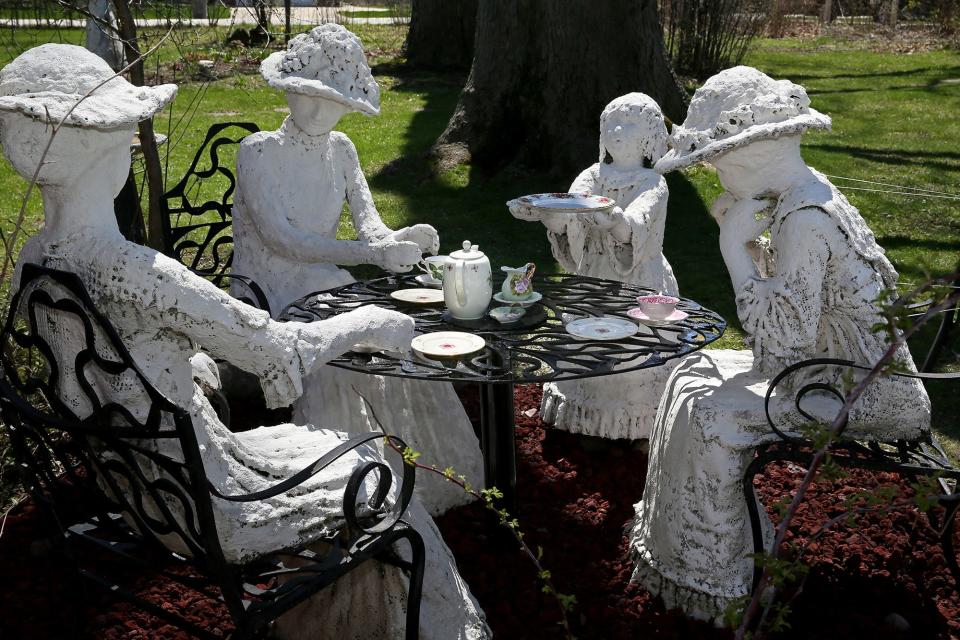
RELATED: In a Third Ward condo situated for spectacular views, she adds oodles of her own flower art
After the purchase, Lindsey-Janusz moved to a smaller home, and she took all but one set of the statues with her.
“She left me the grouping I call the mother and daughter that look like they are swirling in a circle. It was a gift. They’re close to the house, and I can see them from the dining room.”
Stanislawski rented the home out for three years. Then, in 2012, she moved in with Frank Paul, her partner of 12 years. Her mom, Rosemary Stanislawski, later moved in with her, too.
“Before I moved here I had had three different sets of renters and I was really lucky with them. … But after the third tenants left I knew my luck would run out sooner or later, so Frank and I moved here,” she said.
A few years later, Lindsey-Janusz moved to a home with no garden, and she asked Stanislawski if she wanted the rest of the statues. “That would be wonderful,” Stanislawski told her.
They were returned to the property, and Stanislawski and Paul have been maintaining them and loving them ever since.
Artwork all around
In the side yard are the two figurines that look like they are swirling around, and nearby are three women having tea at a table and a child bringing them cookies.
In the front yard, a woman holds a bird, and a little girl looks up at her and holds a doll behind her back.
Near the back of the property, there is a woman peeling apples with two children, a child giving a woman a flower, a woman holding a baby, and an Indigenous woman holding a bowl in each hand.
Lindsey-Janusz also made a life-size bronze statue near the driveway that looks like a woman holding her arms high, as if she just finished a race.
Stanislawski’s gardens (but not the interior of her home) will be featured in this year's Friends of the Muskego Library Garden Walk on June 25.
The couple, who are retired, began making improvements to the 1½-acre property as soon as they moved in. Stanislawski is a certified clinical herbalist, a certified nutritional counselor and a registered nurse.
Her brother, Dave (Stan) Stanislawski, a general contractor who owns Stansen Building and Remodeling in New Berlin, did some of the projects.
But, she said, repairs to the home, which was built in the mid-1800s, happened slowly, as they wanted to restore the home, not just update it. They also had to work within a budget.
Outside, they began cutting down small trees at the back of their lot.
“The woods were really close to the house, so we began removing some of the trees. … And there were no flowers or gardens here, so we began adding those. We also had the gravel driveway regraded,” she said.
Today the yard has a variety of trees, some large and very old. There are apple trees they planted along with a variety of bushes, perennial gardens, a large organic garden and herbs.
“This isn’t an immaculate garden. It’s a more rustic garden, more of a wild garden. I let my herbs grow where they want to grow. I have phlox coming up everywhere. I also have Queen Anne’s lace. I love it. I think it’s stunning."
“We harvest a lot of our apples, and I cook a lot with my herbs. I also make teas and extracts with them. Herbs and nutrition have been a passion of mine for many years,” she said.
Every year she harvests stinging nettles, her favorite herb. She also loves lemon balm, oat straw, lavender and Clary sage. For flowers, she favors iris, bee balm, delphinium, yarrow, holly hocks and lilac.
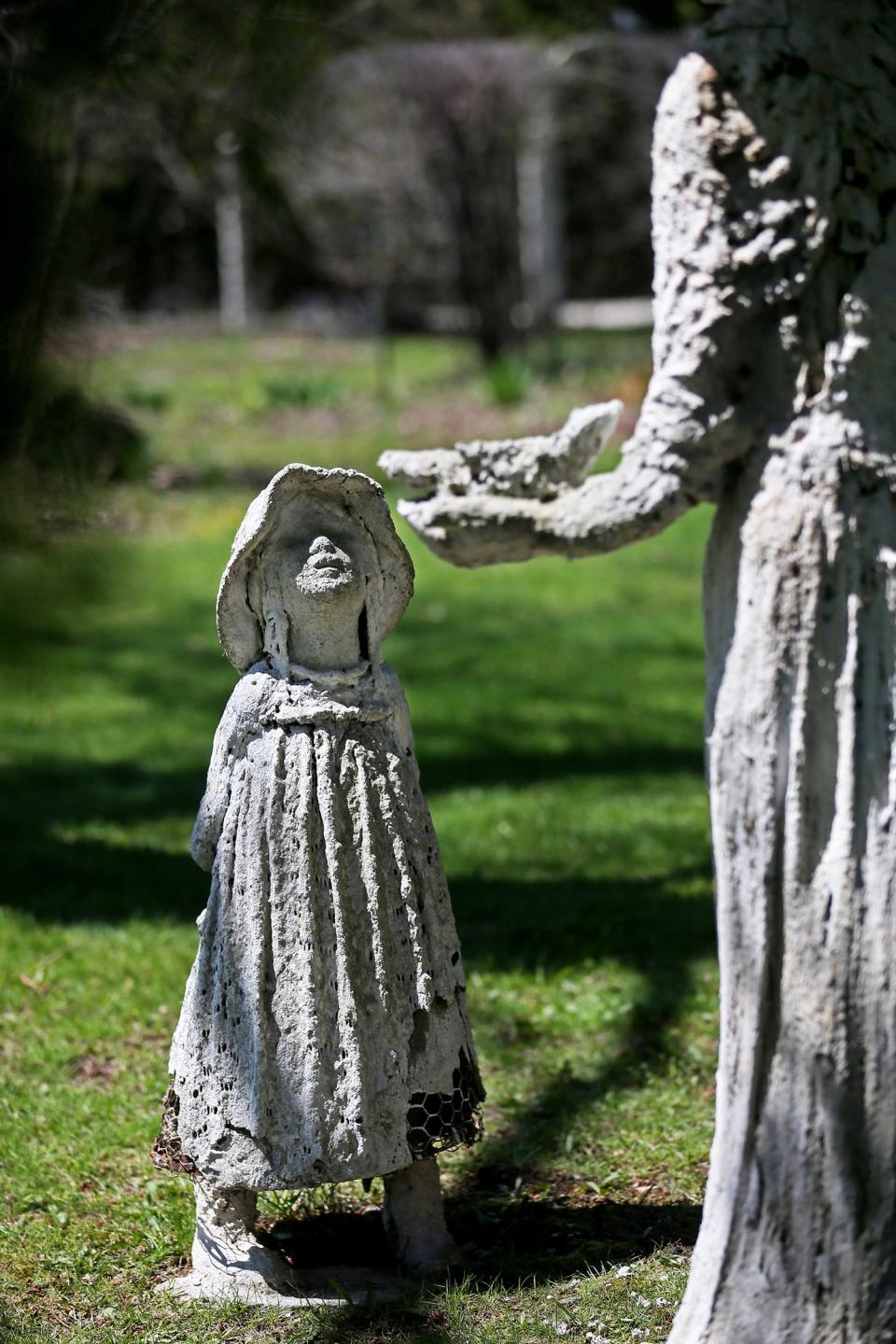
Repairs to the house started with the front and side porches, now painted in the style of a painted lady. An old stoop at the back of the house was turned into a quaint screened porch.
“We painted the porch railings dark brown, barnyard red, ivory and teal. I added teal to the spindles. I did that by hand. At one point I had to use a toothpick to get a proper edge. Doing that gave me a sense of satisfaction,” she said.
The body of the house and the trim were painted, too.
“It was a peachy salmon color. We changed it to an ivory color with deep red and deep brown accent colors.”
When they tackled the inside of their 1,800-square-foot home, they added support beams in the basement, replaced the water softener, iron filtration system, water pressure tank and water heater.
They also gutted the first-floor bathroom.
“It was a disaster. Now it’s very charming. We used fixtures that had a farmhouse style. When we worked in there we found a door that led to the parlor,” she said.
She recently talked about the home, gardens and statues she loves.
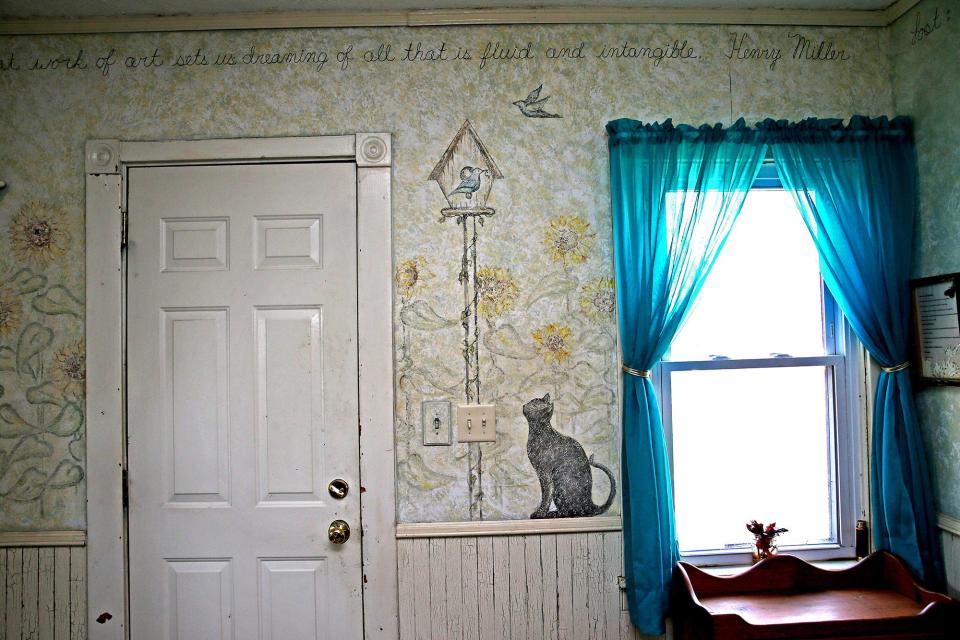
Question: Did Nancy Lindsey-Janusz see any of the changes you made to the property?
Answer: Yes. She said she loved the improvements. She came over several times to hang out. One day we had a statue maintenance day. She showed us how to mix the material and how to apply it. We got to know her pretty well.
Q: How were the statues made?
A: Nancy liked to work with metal. She did a lot of welding. She started with a metal support piece, and then shaped chicken wire around it. Then she put real clothing over that. She used clothing that was lacy looking because she wanted a lacy Victorian look. Then she would put white bonding cement over the clothing to make the cloth hard.
Every couple of years, I have to add more bonding cement. How often I do it depends on the weather.
Q: What statues or grouping of statues are your favorites?
A: The grouping I call the tea ladies. It’s my favorite because of my interest in tea and herbs. They are sitting at a table and the table and chairs were made of steel by Nancy. The arms on some of the statues are reaching out in different directions like they are having a conversation. In that group, there is also a little girl standing there holding a plate of cookies.
I also like the apple lady. That’s a lady sitting on a bench by the apple trees we planted, and she’s peeling apples and there’s a little girl sitting next to her. There’s another little girl in front of her, and she is bringing her more apples to peel.
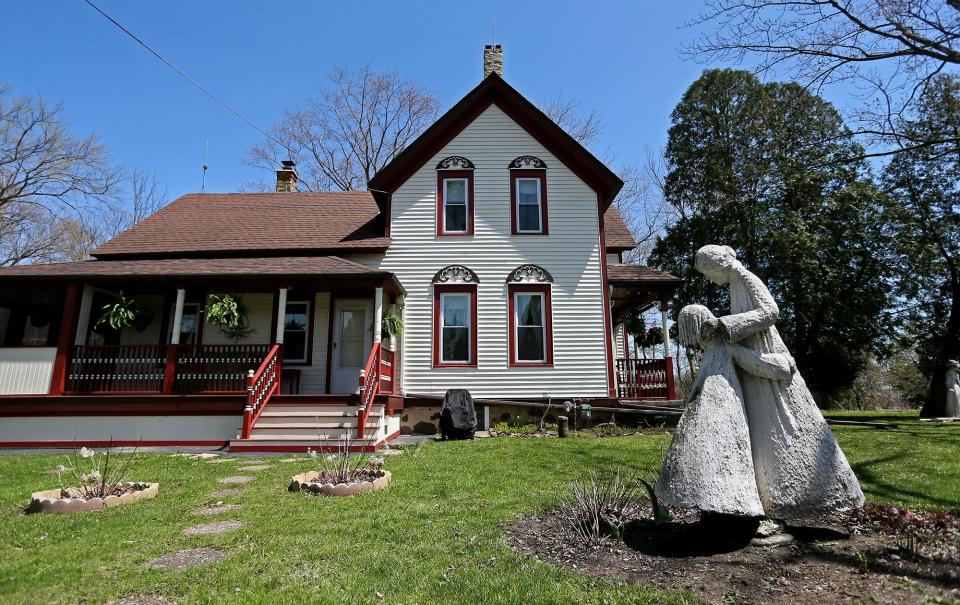
Q: Some of the statues look like they would be holding things like baskets or cups. Were these items originally in the statues?
A: The tea ladies originally had tall cups in their hands. They disintegrated because of the weather. I often put teacups and plates out for the tea ladies. I’ll do that for the tour.
Q: Do people ever stop by and ask about the statues?
A: Yes. Constantly. It’s always interesting because a lot of times, we start talking about the house and the property.
Q: How long does it take you to maintain the statues?
A: This year I will be redoing them all for the tour. I usually do a few of them every year. I put a coat of white bonding cement over them. It takes me three to four hours each. It takes time because you have to get your brush into the pieces of lace. This year we also have to repair some of them, as they are cracking.
Q: Are all the statues in their original places?
A: No. We have moved some of them around. But now we don’t move them. They are really heavy, so you run the risk of them falling over.
Q: Are you the primary gardener here?
A: Yes, but my mom also helps out when she can, and Frank does all the hedge work and yard maintenance.
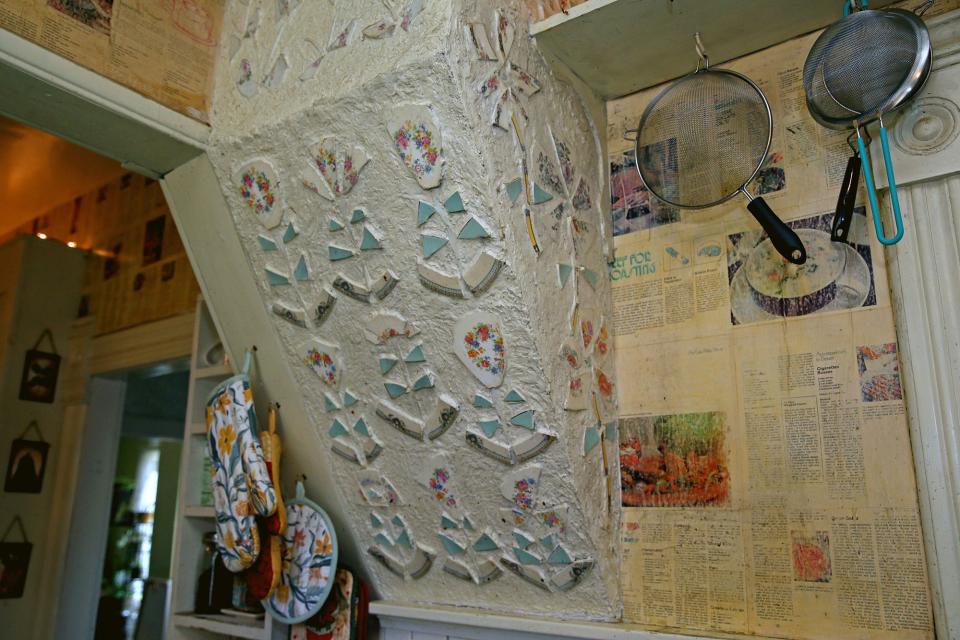
Q: Did Lindsey-Janusz add any artistic elements inside the house?
A: Nancy made a chandelier in the living room. It’s brass with amber-colored glass. There’s also art on the stairway. It looks like a braided rug going up the stairs. Upstairs, there are also braided rugs painted on the floor.
In the dining room, the walls were done with a light green/pale yellow sponge look. Over that she painted sunflowers, and near the door she painted a cat looking up at a birdhouse. And at the tops of the walls she wrote famous sayings about imagination.
Q: How is your home laid out?
A: Downstairs is the living room, dining room, kitchen and bathroom. A room that was originally the parlor, and was later used as a bedroom, is now Frank’s room. There is a door on the outside of the house that used to lead into that room.
I use the other bedroom as my herb room. I love that room. It has built-in shelves that I have all my herbs and books on. I love the bright blue color we painted it, and all the light that comes in.
Upstairs, we have two bedrooms and a bathroom. We were told our bedroom used to be two separate bedrooms. There’s a closet on each side of the room.
Q: What does your kitchen look like?
A: It’s very small. The cabinets are real low to the counter and are really tall. They have glass fronts. The only thing I might do in there is paint them. They’re an ivory color. I really love the kitchen a lot. It’s kind of funky.
Nancy created wallpaper with old recipes from cookbooks. She decoupaged them on the walls. She also made a floral design on one wall out of broken crockery.
Q: Are your living room floors original?
A: Yes, they are a hardwood and are real narrow boards. We have a carpet over it. A dream of ours is to refinish it.
Q: What are some of the amenities in your home?
A: The built-in dining room cabinet, all the original thick molding, the large walk-in attic for storage, the thick four- and six-panel doors, and the wainscoting. I also love the large windows. Some of them are lower to the ground.
Q: Any unique pieces of furniture in your home?
A: We do have some pieces from the Victorian era. I have my uncle’s table and chairs in the dining room, and in our bedroom we have a table from the early 1800s from Frank’s great-great-grandmother.
We also have some antiques we got at yard sales. We have an old dry sink in the dining room. Years ago, they would have had a pitcher and a bowl on it if they didn’t have indoor plumbing. Frank found it at a neighbor's; he was getting rid of it.
Q: Were any big projects done by previous owners?
A: One great thing was that Nancy put in all new windows and doors, a new furnace, and blow-in insulation in all the exterior walls.
Q: Do you know in what year your home was built?
A: No, but Frank said when it was built, Amish barn building techniques were used. You can tell by the way the support beams look in the basement. We also know it’s really old because when we had the bathroom redone, it was taken down to studs, and we could see all the wood was hand hewn.
It also has a fieldstone basement. It was a working farm. We still have the original smokehouse and chicken coop.
Q: What is your home made of?
A: It’s wood frame. It now has vinyl siding on it. We have pictures of the original house.
Do you, or does someone you know, have a cool, funky or exquisite living space that you’d like to see featured in At Home? Contact Joanne Kempinger Demski at .joanne.demsk@gmail.com.
*****
If you go
What: Friends of the Muskego Library Garden Walk: A Bloomin' Good Thyme. Tour four private gardens in the Muskego area and participate in garden-related events. Sponsored by the Friends of the Muskego Public Library. Proceeds will help fund library programs.
When: 9 a.m. to 5 p.m. June 25.
Where: The homes are in Muskego.
Other events: Lecture by nationally known moss gardener Dale Sievert, perennial plant sale, sale of previously owned art, garden craft fair, silent auction and garden boutique. Attend the “Exclusive Garden Tea” for an additional $20. Tickets are available at the library or through the website.
Tickets: $15; children 14 and younger are free. Cash or check only.
For more information: See cityofmuskego.org/library.
Our subscribers make this reporting possible. Please consider supporting local journalism by subscribing to the Journal Sentinel at jsonline.com/deal.
DOWNLOAD THE APP: Get the latest news, sports and more
This article originally appeared on Milwaukee Journal Sentinel: Muskego yard is packed with statues by artist who used to live there

